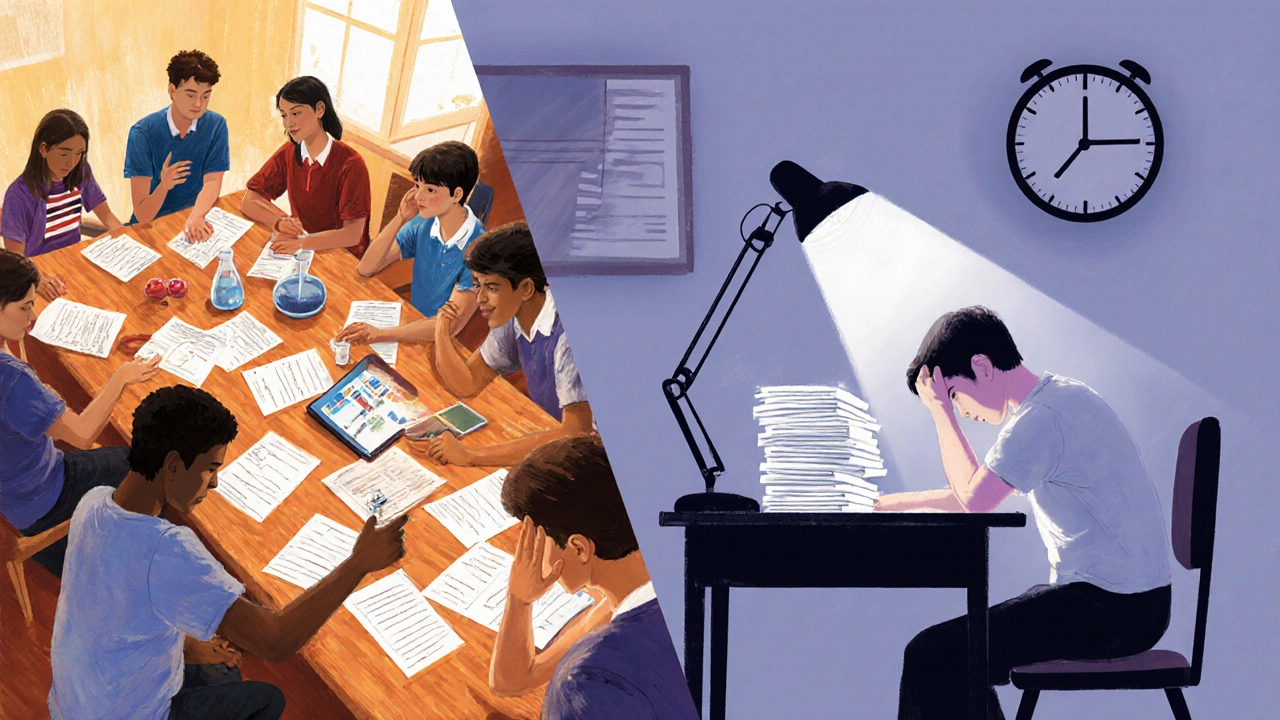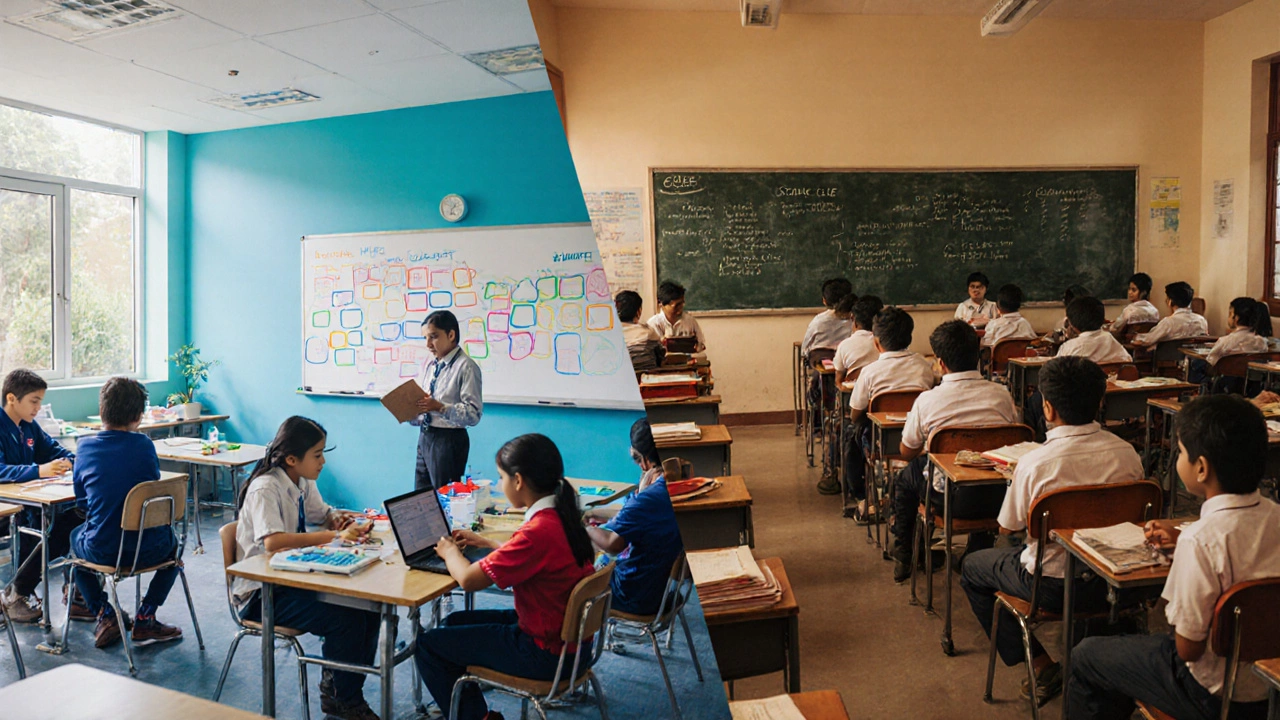American vs CBSE Syllabus Comparison Tool
American Syllabus
Flexible, continuous assessment, broad curriculum with electives.
Continuous Grading Electives AvailableCBSE
Uniform national curriculum, board exams determine grades.
Board Exams Textbook BasedWhen people ask whether the American syllabus is easier than CBSE, the answer depends on many factors - from how subjects are organized to the way exams are scored. This guide breaks down the two systems point‑by‑point so you can see where the real differences lie.
Key Takeaways
- The American syllabus offers more flexibility and continuous assessment, while CBSE relies heavily on year‑end board exams.
- Both systems cover core subjects, but the depth and pacing differ; CBSE tends to be more content‑dense.
- Study load varies by school type; a typical American high‑school student spends 10‑12 hours/week on homework, whereas CBSE students often log 15‑20 hours.
- College readiness tools (GPA, SAT, AP) give U.S. students multiple pathways, while CBSE’s focus is on a single board exam for university admission.
- Neither system is universally "easier" - suitability depends on learning style, language proficiency, and career goals.
What the American syllabus looks like
American syllabus is a collection of state‑level curricula that follow the Common Core standards for English and Math, plus subject‑specific guidelines for science, social studies, and electives. Schools may add Advanced Placement (AP) courses or International Baccalaureate (IB) tracks for extra depth.
Typical structure:
- Grades K‑12, divided into elementary (K‑5), middle (6‑8), and high school (9‑12).
- Credits earned each year; students need a minimum number to graduate.
- Continuous assessment: quizzes, projects, class participation, and semester exams.
What CBSE delivers
CBSE (Central Board of Secondary Education) is the national board for India’s 10+2 system. It sets a uniform curriculum for over 20million students across public and private schools.
Key characteristics:
- Grades 1‑12, with a major split at the 10th‑grade board exam and the 12th‑grade “Higher Secondary” exam.
- Core subjects: English, Mathematics, Science, Social Science, and a second language.
- Mostly textbook‑driven learning; board exams carry 80‑100% of the final grade.
Assessment styles: continuous vs board exams
Continuous Assessment in the U.S. includes regular quizzes (5‑10% of the grade), project work (10‑20%), and quarterly tests (30‑40%). The final semester exam typically accounts for 20‑30%.
In contrast, Board Exams under CBSE are high‑stakes. The 10th‑grade and 12th‑grade papers together decide 80‑100% of a student’s result. This single‑event pressure can feel tougher for many learners.

Curriculum breadth and depth
The American syllabus tends to be broader. For example, a 10th‑grade American student might take elective courses like Computer Science, Art, or Business, each with its own standards. The focus is on concepts and applications rather than rote memorization.
CBSE’s curriculum is deeper and more uniform. The Science syllabus covers detailed chapters on Physics, Chemistry, and Biology, often requiring memorization of formulas and definitions. Textbooks are prescribed nationwide, and teachers follow a set timeline.
Teaching methods and classroom dynamics
U.S. classrooms encourage discussion, group projects, and inquiry‑based learning. Teachers act as facilitators, and AP (Advanced Placement) courses let motivated students dive into college‑level material.
CBSE classrooms are traditionally lecture‑centric, though recent reforms promote “Skill‑Based Learning.” Still, large class sizes (30‑40 students) and limited lab access can restrict hands‑on experiments.
Workload and study hours
Average weekly homework for an American high‑schooler is about 10‑12 hours, split across subjects. Because grades are cumulative, a low score on one quiz can be balanced by later work.
CBSE students often report 15‑20 hours of study per week, especially in the months leading up to board exams. The intense revision period (often called “exam season”) adds extra hours.
College readiness and grading
U.S. students graduate with a GPA (Grade Point Average) on a 4.0 scale, plus standardized test scores like the SAT or ACT. AP exam scores (1‑5) can earn college credit, giving multiple pathways to higher education.
CBSE students rely mainly on their 12th‑grade board marks (percentage) for university admission. Competitive exams such as the NEET (Medical) or JEE (Engineering) are separate, high‑pressure tests that follow the board results.
Side‑by‑side comparison table
| Aspect | American syllabus | CBSE |
|---|---|---|
| Curriculum structure | State‑based + Common Core; flexible electives | National board; uniform textbooks |
| Assessment type | Continuous (quizzes, projects, semester tests) | Two major board exams (grade10 & 12) |
| Study load (weekly hrs) | 10‑12hrs | 15‑20hrs (peak season higher) |
| Grading metric | GPA0‑4.0, SAT/ACT scores | Percentage0‑100% |
| College credit options | AP, IB, dual‑enrollment | None directly; rely on board marks |
| Flexibility | High - students can switch tracks, add electives | Low - fixed subject list |
| Teaching style | Discussion, project‑based, inquiry | Lecture‑centric, textbook‑driven |
When might one feel easier?
If you thrive on steady, low‑stakes feedback, the American system’s continuous assessment feels less stressful. The ability to improve a grade through projects or extra credit can cushion a bad quiz.
Conversely, students who prefer a clear, single‑shot goal may find CBSE’s board exams more straightforward - there’s no need to track multiple component grades throughout the year.
Language proficiency also matters. The American syllabus uses American English and often incorporates multicultural content, which can be a plus for native English speakers but a hurdle for those whose first language is Hindi or another Indian language.
Tips for navigating each system
- American syllabus: Stay organized with a digital planner; treat each quiz as a chance to boost your GPA.
- Leverage AP or honors classes early if you want college credit and a stronger transcript.
- CBSE: Create a revision calendar 6‑8months before board exams; focus on solving past papers.
- Join study groups to share notes, especially for science subjects that require lab concepts.
Frequently Asked Questions
Is the American syllabus less content‑heavy than CBSE?
Generally, yes. The U.S. system spreads concepts over multiple years and adds electives, so each subject isn’t as densely packed as the CBSE textbook chapters.
Do American high‑school students take national exams like CBSE’s board exams?
No single national exam determines graduation. Instead, students compile a GPA and may take optional standardized tests (SAT, ACT) for college admissions.
Can a CBSE student switch to the American syllabus midway?
Transition is possible but varies by school. Credits may need re‑evaluation, and the student must adjust to continuous assessment and different grading scales.
Which system better prepares students for global universities?
The American syllabus offers more direct pathways (AP, IB) that many overseas universities recognize. CBSE students often rely on additional entrance exams (SAT, IELTS) for international admissions.
Is one system cheaper for families?
Public schools in both countries are tuition‑free, but ancillary costs differ. U.S. families may spend more on textbooks, extracurriculars, and standardized test fees, while Indian families often invest heavily in coaching for board exams.

